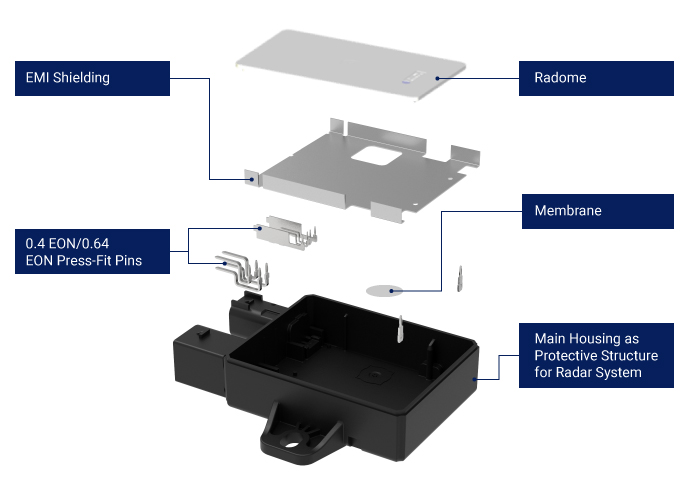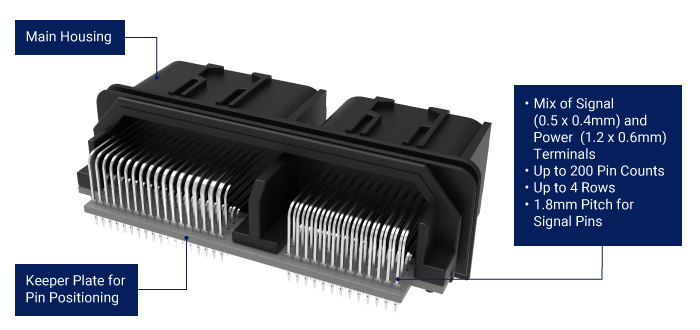By Ralph Semmeling, Product Portfolio Director for Customized Connectors at ENNOVI
Automotive designs are becoming increasingly complex, with more sophisticated functionality being incorporated to enhance comfort, boost performance, and ensure greater safety. The number of sensors and imaging devices being incorporated into vehicles is rising dramatically. This is not just happening at the luxury end of the market – with mid-range and even economy models having extra functionality added.
At the same time as this is happening, other dynamics are changing the way automobile designs are implemented. In order to remove weight and thus extend the range of electric vehicles (EVs), the mechanical systems that used to be incorporated are being phased out. In their place, vehicle designs will have electronically based x-by-wire systems.
There is one avoidable consequence that these two different trends are going to be responsible for. The amount of data that the average vehicle is going to be generating and transporting is going to be orders of magnitude greater than what conventional cars had to deal with. Further, it should be noted that this is only going to increase as higher levels of vehicle autonomy start to be introduced (and we start to migrate to a stage where cars are completely driverless).
The data explosion and its implications
Analyst firm McKinsey estimates that the average car is already generating somewhere in the region of 25GB of data on an hourly basis. This is just the beginning though. The number of cameras installed within the interior and on the exterior of vehicles is continuing to increase and 3D imaging technology – such as LiDAR, time-of-flight (ToF) and ultrasound – set to be a commonplace feature in just a few years’ time.
If automotive systems are going to be adequately prepared to cope with the unprecedented data demands, then the supporting interconnect solutions will need to evolve accordingly. In addition, how such solutions are constructed and provided to the market is going to fundamentally change.
Implementing interconnects into automotive systems
There are various attributes that it is essential for interconnects to possess if they are to prove effective in challenging automotive environments – and comply with stringent international standards, such as the EU’s LV214 and the SAE’s USCAR2. Firstly, they need to be able to withstand exposure to shocks and vibrations. Then there is exposure to high temperatures to consider (though this will become less problematic as the industry migrates from ICEs to EVs).
The presence of electromagnetic interference (EMI) sources, if not mitigated, could have a detrimental effect on the signal integrity of the data being transported. To combat this, shielding will need to be incorporated into modules. The appearance of tin whiskers over time can have a serious impact on the reliability of interconnects, with the prospect of short circuits occurring that could result in system malfunctions.
Also, the space limitations imposed on vehicle designs mean that automotive-grade interconnects have to be of a very compact nature. Often high-density solutions will be needed. In some cases, these may need to combine power and data transfer.
Addressing the assembly aspect
As well as the performance and reliability of the interconnects themselves, tier 1s producing Electronic Control Units (ECUs) and sensor modules have to think about how interconnect integration will affect the high-volume assembly processes being utilized. If fitting of the interconnects slows down the workflow, by adding to the number of steps that must be completed, then this will mean that throughput will be impacted upon. For example, if it requires rotation of the Printed Circuit Board (PCB) so that it is orientated in a different way, time is going to be wasted. Also, if the interconnect means that assembly needs human intervention (instead of being fully automated) then the process will take even longer (and the risk of errors occurring will be increased considerably too).
Because of these issues, Press-Fit interconnect technology is becoming increasingly appealing. Press-Fit contacts provide a reliable yet simple interface. By using them, assembly work can be made much more efficient. Complex, labor-intensive and messy procedures (such as soldering) may likewise be avoided.
By eliminating the need for applying solder, another significant advantage can be derived. Whereas solder is totally rigid, and therefore prone to cracking if subjected to shocks/vibrations, Press-Fit contacts have greater tolerance. Consequently, modules with Press-Fit contacts will offer greater operational longevity than ones with soldered pins.
The Press-Fit contacts developed by ENNOVI are now being widely used in automotive systems, gaining approval from numerous tier 1 suppliers. With thicknesses from 0.4mm up to 0.8mm, they deliver ongoing reliable operation, while being simple to install. As well as their mechanical robustness, they also have strong retention and industry-leading thermal characteristics too.
Through the patented IndiCoatTM plating technology that can be applied to Press-Fit interconnects, ENNOVI is in a position to overcome the difficulties that tin whiskers cause other suppliers. The quality of the end-product is thereby assured for a prolonged period.

There are a large number of automotive companies that are looking to offload their ECU/sensor module design work. Rather than doing this in-house, or via their tier 1 suppliers, many are now relying on ENNOVI to undertake these activities. This is allowing such companies to focus the engineering resources where they can gain the most differentiation.
By engaging with ENNOVI, automobile brands are able leverage industry-leading expertise in areas like high-precision mechanical engineering and coating technology. Among the numerous kinds of modules that have been designed and manufactured by ENNOVI for automotive deployment are the radar unit and airbag ECU shown in Figures 2 and 3 respectively.


What is pivotal to the way in which ENNOVI approaches customer projects is the modular manufacturing methodology that it has established. Here, a large proportion of fixed elements are shared between different unit designs, but there are still certain key places remaining where it is straightforward for adaptations to be applied. This means that the price that customers need to pay is lower, as brand-new tooling is not needed for every single module, and acquisition of additional capital equipment can be kept to a minimum. New production workflows no longer have to be created from scratch, as there are just amendments to what was done in relation to previous modules.
Harmonizing the manufacturing techniques being used allows a broader number of automotive customers’ module requirements to be covered via one adaptable platform. This provides these customers with a compelling balance. They can make the units incorporated into their vehicle models distinct, but still keep the overall costs involved down – and in doing so protect their margins.
Conclusion
It is clear that modern automobile manufacturers and their tier 1 partners need to have access to superior interconnects. Not only must these deliver elevated performance and long-term reliability that have always been expected in this sector. Now, they must go beyond that – and also offer straightforward assembly plus ample scope for adaptation, so that overall costs can be kept down, and production output maximized.
Having served with automotive customers for many decades, the technical team at ENNOVI has huge insight into what will be needed for the new breed of cars currently under development, as well as those that are still in the concept phase ahead of future release. Inclusion of Press-Fit pins in ECU and sensor modules makes assembly much easier – resulting in accelerated production procedures that will help boost profitability. Furthermore, by following a top-loaded, platform-based approach in the construction of these modules, enough flexibility can be realized to make the process far more cost effective as possible.
Talk to an expert and get your queries answered: Connect with Us – ENNOVI
